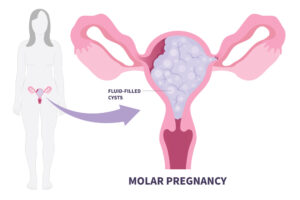When fertilization is successful, the sperm and the egg fuses to form an embryo and, eventually, a baby. However, on rare occasions, something goes wrong and results in what is known as molar pregnancy. Joining us is Dr Janani Sivanathan, a consultant obstetrician and gynaecologist as well as a maternal-foetal medicine sub-specialist, to tell us more about it.
WORDS LIM TECK CHOON
 FEATURED EXPERT FEATURED EXPERTDR JANANI SIVANATHAN Consultant Obstetrician and Gynaecologist and Maternal-Foetal Medicine Subspecialist Sunway Medical Centre |
| This article talks about pregnancy loss and molar pregnancy. If you’ve experienced pregnancy complications, loss, or are trying to conceive, some parts may be painful to read. Please take care of yourself and proceed only if and when you feel ready. |
MOLAR PREGNANCY IS A FORM OF ABNORMAL PREGNANCY
Molar pregnancy is sometimes called mole (not to be confused with the animal or the skin growth), a hydatidiform mole, or gestational trophoblastic disease.

- It is also called ‘hamil anggur’ because of the presence of grape-like fluid-filled sacs seen in the uterus during an imaging test (see image above).
- This ‘bunch of grapes’, called hydatidiform, is composed of placenta tissue that swells up and forms a tumour.
- This tumour is usually benign or not cancerous. It can become cancerous, but only very rarely.
“There are 2 types of molar pregnancy: partial molar pregnancy and complete molar pregnancy,” says Dr Janani Sivanathan.
Partial Molar Pregnancy
An embryo is formed after fertilization, but this embryo has an abnormal number of chromosomes due to 2 sperm cells fertilizing a single egg.
- The embryo may further develop along with the placenta.
- However, because of the genetic abnormalities in the embryo, it won’t survive.
- As a result, in most cases, the woman will experience a miscarriage early in the pregnancy.
Complete Molar Pregnancy
Unlike partial molar pregnancy, this is no embryo formation.
- This is usually due to the egg cell not having genetic materials, so it cannot develop into an embryo even after fertilization by a sperm cell.
- Instead, there is only placenta tissue growing in the womb.
- However, the woman may still experience symptoms of pregnancy, and a pregnancy test will come up positive.
- In certain instances, the urine pregnancy test may be a false negative. This is due to extremely high levels of pregnancy hormones known as beta human chorionic gonadotrophin or β-hCG.
IT CAN HAPPEN TO ANY WOMAN AND IT’S NOT HER FAULT
Molar pregnancy is rare, but it can happen to a woman of any age and race.
- It is an accidental mistake that occurs during fertilization, so there’s no way to prevent it from happening.
- A molar pregnancy is not caused by anything the woman did.
- It is possible for a woman to experience a molar pregnancy even after having given birth to healthy babies in the past.
On the bright side, Dr Janani says that this also means that a woman that experienced molar pregnancy can have a normal, healthy pregnancy in the future.
MOLAR PREGNANCY MAY NOT ALWAYS SHOW SYMPTOMS
Dr Janani reveals that some women may not realize that they are experiencing a molar pregnancy until they go for a pregnancy ultrasound check.
Other women may experience certain symptoms, the most common of which are:
- Bright red to dark brown bleeding within the first 3 months of pregnancy, sometimes with white grape-like tissues and clots
- Pressure and/or pain in the pelvis
- Abdominal swelling
- Abnormally high blood pressure
- Abnormally high levels of the hormone human chorionic gonadotrophin or HCG
The doctor will confirm the presence of a molar pregnancy with an imaging test such as transabdominal or pelvic scan and a blood test for Beta-hCG levels.
UNFORTUNATELY, THERE IS NO ‘SAVING’ THE PREGNANCY
As Dr Janani explained earlier, molar pregnancy is not a normal pregnancy.
The embryo either does not develop into a foetus in the case of complete molar pregnancy, or it will not survive due to its genetic defects in the case of partial molar pregnancy.
While it can be heartbreaking for a woman that believes that she is pregnant and is looking forward to having a healthy baby in her life, the best course of action in this situation is to remove the molar tissue from the womb.
This is necessary to avoid potential future complications such as:
- Invasive mole. Molar tissue grows into the uterus. This is a type of cancer and is generally treated with chemotherapy.
- Choriocarcinoma. This is a cancer formed from the cells of the placenta. It’s usually treated with surgery and/or chemotherapy.
- Infection of the uterus and/or blood.
- Complications related to abnormally high blood pressure such as preeclampsia.
Dr Janani explains that the removal of molar tissue is done via a procedure called suction and curettage, or S&C for short.
- The obstetrician will use an instrument to dilate the vaginal opening if needed.
- Then, with a surgical instrument called suction cannula, the obstetrician will remove molar tissue with the aid of suction pressure.
- This is done under ultrasound guidance to ensure complete evacuation and to prevent complications such as uterine perforation.
- This entire procedure will be performed while the woman is under anaesthesia.
There will be some follow-up after this procedure, as the obstetrician will need to be certain that the levels of hCG hormone are declining and there is no molar tissue left inside the womb.
MOLAR PREGNANCY WILL NOT END A COUPLE’S DREAMS OF HAVING A BABY
Dr Janani iterates that a molar pregnancy will not affect a woman’s chances of having a successful pregnancy in the future.
However, she should wait until she completes her medical follow-ups, and her obstetrician gives the green light that it is fine to try again.
In the meantime, she and her partner should use an appropriate form of contraception while having sex.
| This article is part of our series that focuses on pregnancy. |











